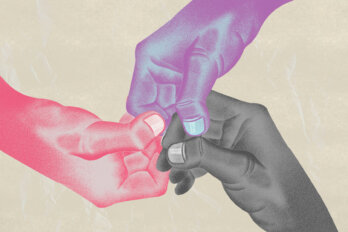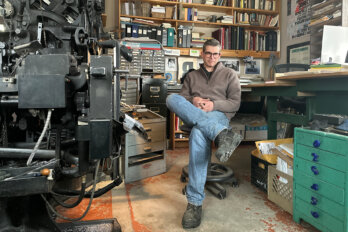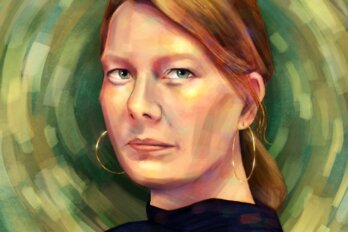Every year, my mother takes a day off to deal with my father’s socks; otherwise, they pile up in laundry baskets and closets all over the house, clean but unfolded. Once, she left me a message, in a voice thick with fatigue: “Big, thick woollies turned out to be twenty-nine pairs and sixteen odds. The whites were thirty-nine pairs, forty-four odds. I found eleven pairs with logo, nine straight up, some with grey soles. I haven’t done the greys, but that’s enough.”
My mother, a feminist who once led women’s groups in our living room, says that she finds it easier, after decades of marriage, to sort my father’s socks herself, rather than to nag him or turn a blind eye to the chaos. Strangely, I have found myself doing the same. I folded socks while my first boyfriend, in university, became a writer. I folded socks while my most recent live-in boyfriend watched football, did work, and—actually, I have no idea what he was up to, because I was folding his socks (and sometimes ironing them). No one asked me to do this. I didn’t mind. There is a real sense of satisfaction in finding a sock, rummaging for its mate, and lovingly pairing them, all in the service of someone else. But ever since that last relationship ended, more than five years ago, I have viewed any potential partner through this lens: would it be worth taking on his hosiery with him? And, every time, the answer has been no.
In 2011, The Atlantic published a story, “All the Single Ladies,” that went viral. The author—thirty-nine-year-old Kate Bolick, a single, professional woman—asked for a radical favour: that she not be pitied. In fact, she argued, she was doing fine. With the rise of women in the workplace, and the softening of gender roles generally, there are fewer traditional, high-earning “alpha” males with which powerful women can partner up. Marriage no longer holds the social and economic advantages it once did. Given a choice between “deadbeats” and “playboys,” women can, instead, opt for neither.
This idea was not exactly breaking news to anyone who has dated the aspiring novelist or the something-slash-DJ. But it reversed a truism endlessly drilled into women who came of age in the 1980s and ’90s: that we have “forgotten” to have children, or have prioritized our careers so much that, by the time we are ready, our fertility is fading, and men no longer want us. Instead, the fault for our singlehood might not lie in us but in the changing nature of relationships. Her further audacity was to suggest this might be a good thing. The resulting digital cocktail of backlash and support, along with coverage in media outlets worldwide, helped her turn “All the Single Ladies” into a six-figure book deal. Summoned to account for herself before society’s ultimate tribunal, morning news, Bolick was unapologetic. “It’s an opportunity for women in general, and for marriage as an institution,” she explained to a bemused host of The Today Show.
At the time, I was wary of the discussion. Even as a feminist retelling of the spinster fable, Bolick’s point seemed to confirm one of my real fears: I might, in fact, be alone for the rest of my life. It also sounded disingenuous. In my group of friends, which includes single women in Toronto and New York, I think it is fair to say that everyone would like to be married. Finding a husband and having children remain standing topics of discussion at brunch. The world around us, from Jennifer Aniston’s latest attempt to find happiness to the well-meaning relative who asks if you’ve considered freezing your eggs, reminds us that it’s not too late. A forty-seven-year-old acquaintance of mine recently gave birth to twins. No matter how you dress it up, the idea that we should be fulfilled by single life—first dates; spoiling our nieces with tiny Moncler jackets; guys who, in the words of one of my girlfriends, “just want to pull on their pants and leave”—is depressing.
Bolick’s new book, Spinster: Making a Life of One’s Own, depicts a gentler, more encouraging view, even if it is set in the ruthless world of Manhattan dating. Both a personal and social history, it retraces her decision, at age twenty-eight, to leave the kind of relationship my mother would have urged me to stick out: nice but unsatisfying. Bolick spent the next decade trying to understand what she was looking for, via a whirlwind love life and a series of characters that will be familiar to many single female readers: the sexually satisfying but emotionally distant older man; the fun younger guy who poses no threat to her independence but isn’t looking for anything serious.
All this makes the book sound narcissistic. But, as a woman in roughly the same situation as Bolick, I can tell you that the endless social interrogation of our singlehood practically forces us to be narcissistic. Those 3 a.m. nights, staring at the ceiling: Is it that I’m just too picky? Have men changed because of Internet porn? Is it this time on earth, the city I’m living in? Am I this century’s Joan of Arc—somehow destined for solitude? The book is similarly elliptical, self-reflective: we go back to Bolick’s mother, who died when the author was just twenty-three. “I had my own aspirations to live out,” Bolick writes, “but also hers.”
In the search of an alternative, Bolick looks to earlier, inspirational spinsters. All are literary, perhaps because, in the early days of women’s rights, journalism and “dabbling” were two of the only occupations available for respectable women. These foremothers include Maeve Brennan (The New Yorker’s “The Long-Winded Lady”); Neith Boyce, whose column The Bachelor Girl debuted in Vogue in 1898; Edna St. Vincent Millay, whose impeccable poems captured her sexual appetites; and Charlotte Perkins Gillman, a staple of the women’s studies canon for her story “The Yellow Wallpaper.” (Here, however, she is depicted not as a victim of post-partum depression, as I took her to be, but as a shrewd social critic.) When they spoke, many of these women sounded surprisingly modern. “I never felt that I could give up my life of freedom to become a man’s housekeeper,” writes Susan B. Anthony, in a letter to the reporter Nellie Bly from 1896.
Above all this looms Sex and the City. It is worth noting how singular that show, now almost twenty years old, remains. There is little else as a model for how modern single women can live; its influence is at this point tautological. I remember one critic calling it out not for its heroines’ behaviour—sleeping around, spending the rent money on Jimmy Choos—but for their selfishness. That may be the real throughline of this discussion. Bolick admits that avoiding marriage—the ultimate season finale—leaves her feeling guilty, self-involved. “Why must women always be leaving marriages to find what they want? ” she recalls asking as far back as her early twenties. At the end of the book, Bolick is in her early forties and dating a younger man. Even if she remains unmarried, she concludes that, whatever else happens along the way, she can still lead an interesting life.
The word spinster was first used to connote independence—literally, a woman who spun fabric, indicating that she could provide for herself and did not have to marry. Over the centuries, it evolved to mean a woman who had not married and, most recently, a woman who cannot be loved. That insinuation of unacceptability—the individual as unfuckable—is at the root of our fear of being alone. “Workin’ on my night cheese,” one of Liz Lemon’s most memorable lines from 30 Rock, sung off-key as she eats in front of the TV, depicts the unmarried woman as so far outside social norms that she has devolved into a dude. If one removed the stigma of the spinster, what would she be? A bachelor, having a good time. George Clooney before Amal Alamuddin.
In an attempt to be kind, my therapist once encouraged me to think of myself as Clooney: a good-looking, successful person who had a hard time finding his equal. “No one questions the value of George Clooney,” she said. As Bolick writes, this distinction—between making a choice and having been chosen—takes freewheeling bachelorhood off the table for women. “Are women people yet? ” she asks, rhetorically. Feminists have posed that question to gain the vote, win reproductive rights, retain maiden names. Bolick is, in the end, not decrying marriage so much as demanding the right to be alone—something men have long taken for granted.
But, until recently, it hadn’t occurred to me that I might never get married. It came as a surprise that, having “done the work” in my last relationship—seen the therapist, read the books, tried all the patience and humour and lingerie—my own family wound up begging me to leave. “I’ll get a truck this weekend,” my dad said. “No questions asked.” The promise of finding my “real” husband was what finally gave me the courage. I figured it would take a year. It has been five. In that time I have graduated from beginner to intermediate hip-hop class. I have ascended the corporate ladder. I now make more than my ex-boyfriend did. I have also met a number of interesting men, some of whom have become lovers. But none of them “stuck.” They passed by as a parade of half-hearted commitments, their exits marked by a few mumbled words of apology, if not outright “ghosting”—a reality of the OkCupid era and a real Cosmopolitan topic. It may be that we’ve entered a new age of non-commitment, as some experts suggest. What has changed, Bolick might argue, is that this could be a good thing.
It’s hard not to consider, in all of this, the impact of divorce. Many of us grew up in the 1970s and the ’80s, when the norms of custody and child support were being established. There were custody battles so rancorous that one family I know did the weekly handoff on the police station’s front lawn. What grown woman hasn’t seen the consequences of marriage after the love is gone? Our own peer group is littered with the detritus of first marriages. I suspect that, like a lot of children of divorce, I grew up determined to avoid the mistakes of my parents’ generation at all costs.
As a single person, love seems like the most abundant natural resource around: it’s in every Tinder match, every set-up, every Craigslist Missed Connection. The problem is how to keep it—or, rather, how to process this raw crude of the heart into marital fuel. Bolick’s book is a messy introduction to a conversation that nobody knows how to have. In what amounts to a thesis paragraph, almost at the end, she writes, “It’s important to remember that the widespread practice of marrying for love—not responsibility to family and community—is only about two hundred years old. Women have been pursuing professional careers for half that time, but in significant numbers only over the past forty years.”
I remember the first time I knew that I wanted to be someone’s wife. I was twenty-seven. We were in the car, driving back from a night in a hotel, or maybe it was a weekend in Montauk. The morning light streamed through the window. We were listening to jazz. The man who was driving was an inconceivable combination of a professional and an artist, and lived in Manhattan. He was ten years older, and in that moment I saw the advantage of being at his side. It seemed a tremendous but worthy sacrifice of my girlhood.
Of course, we didn’t last. With the kindness of one who recognized the situation for what it was, he let me go at the end of the summer. What I have since come to realize is that a smart woman doesn’t have to marry that man to achieve the vision he inspires. She can become him instead.





